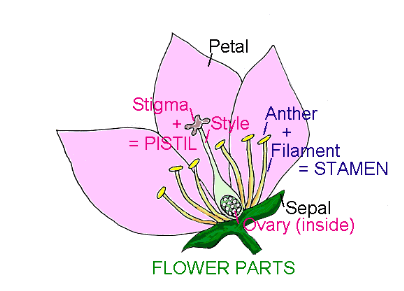How
Seeds are Formed
 I know that you have all
looked at flowers, but have you ever had a REALLY, REALLY close look? Flowers
are very interesting and they are made up of a number of different parts. These
parts may differ in size, shape and position from flower to flower, but the
major organs can usually be seen quite easily if you look closely. A magnifying
glass helps you to see the parts even better. These are the reproductive organs
of the plant and are used to create seeds and therefore new plants.
I know that you have all
looked at flowers, but have you ever had a REALLY, REALLY close look? Flowers
are very interesting and they are made up of a number of different parts. These
parts may differ in size, shape and position from flower to flower, but the
major organs can usually be seen quite easily if you look closely. A magnifying
glass helps you to see the parts even better. These are the reproductive organs
of the plant and are used to create seeds and therefore new plants.
You will need: flowers, a magnifying glass
1. Choose largish flowers. This makes it
much easier to see. Lilies, camellias, azaleas, single roses, jonquils,
daffodils and citrus flowers are all fine. Don't choose daisy flowers because
they are actually made up of hundreds in tiny individual flowers and are too
small to see clearly. (With some flowers you will have to pull the petals apart
gently to reveal the flower parts at the centre. A adult may slice the side off
the flower for you with a Stanley knife so that you can see better.)
2. Look at the diagram and then see if
you can recognise the parts in your flower. (They might be shaped differently.)
Here are some general tips:
 There is only one stigma (it may be
branched at the top), but many stamens.
There is only one stigma (it may be
branched at the top), but many stamens.
 The anthers are often yellow. If you
look through your magnifying glass you may be able to see lots of little grains
of pollen covering them.
The anthers are often yellow. If you
look through your magnifying glass you may be able to see lots of little grains
of pollen covering them.
 The tip of the stigma is often
sticky-looking (it may have some pollen grains stuck to it too.)
The tip of the stigma is often
sticky-looking (it may have some pollen grains stuck to it too.)
 Donít worry if you canít see any
calyx. Some flowers have tepals instead of petals and there is no calyx. Tulips
have tepals.
Donít worry if you canít see any
calyx. Some flowers have tepals instead of petals and there is no calyx. Tulips
have tepals.
3. The stamen is made up of the filament
and the anther. The stamen is the boy bit of the flower. The pistil is made up
of the style, stigma and ovary. The pistil is the girl bit.
4. The anthers release pollen which has
to be transported to a stigma. Some plants allow pollen from their own anthers
to pollinate their own stigmas. This is called self-pollination. (Their stamens
are usually longer than their pistils. Can you think why?) Other plants need the
stigma to receive pollen from a flower on a separate plant. This is called
cross-pollination. (Their pistils are often longer than their anthers.) The
pollen is carried by wind, insects (especially bees), animals or birds and
sometimes water.
5. When a correct pollen grain lands on a
stigma that is ready to be fertilised, the pollen grain sends down a long tube
all the way down the style to the ovary where it fertilises one of the female
eggs and a seed begins to form.
 I know that you have all
looked at flowers, but have you ever had a REALLY, REALLY close look? Flowers
are very interesting and they are made up of a number of different parts. These
parts may differ in size, shape and position from flower to flower, but the
major organs can usually be seen quite easily if you look closely. A magnifying
glass helps you to see the parts even better. These are the reproductive organs
of the plant and are used to create seeds and therefore new plants.
I know that you have all
looked at flowers, but have you ever had a REALLY, REALLY close look? Flowers
are very interesting and they are made up of a number of different parts. These
parts may differ in size, shape and position from flower to flower, but the
major organs can usually be seen quite easily if you look closely. A magnifying
glass helps you to see the parts even better. These are the reproductive organs
of the plant and are used to create seeds and therefore new plants.